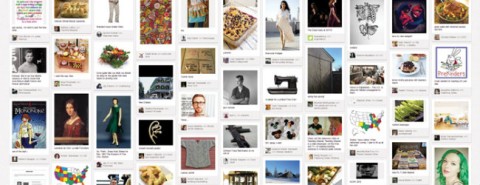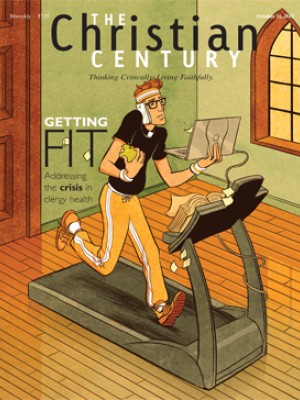Pinterest and porn

Like millions of other people, most of them women, I recently joined Pinterest. This online photo-sharing site is used to organize and recommend images according to topic or theme. The popular images on this virtual pinboard include cute baby animals, stunning gowns worn by toned models, elaborate cupcakes, shirtless men and beautiful cabinetry. Clothing, home décor and recipes are among the most common topics. Users can post images from other websites or “repin” images from other users.
The images may be nothing new, but the effect of aggregating and then sharing them is. Pinterest generates enormous amounts of Web traffic, and when users click links on Pinterest, it translates into dollars for retailers and bloggers.
The success of Pinterest seems to come from a visceral connection users have with the glossy virtual pinboards. What is the power of these images? Why the fascination? Whence the allure? And why are the pinners overwhelmingly female?
Theologians have generally had two views of images. One group worries that they are idolatrous—dangerous decoys that draw us away from the ineffable divine. Another group thinks that Christians ought to be the most committed of visual artists, celebrating the things of God in the beauties of creation. Implicit in both views is a recognition of the power of images. Human beings are visual creatures, and what we see matters to who we are.
Read our latest issue or browse back issues.
My own sympathies tend against the iconoclasts. I tend to emphasize, in the light of the incarnation, how images can communicate the goodness of God. But this seems insufficient when I consider Pinterest. How often have the images on Pinterest—images of thinness, wealth and fashion—been used against women, the very audience that flocks so happily to the site?
When I ask an artist friend about the difference between art and pornography, his response lines up with my intuitions. Art helps us to see the world, making us “sensitive, present and aware of the world around us.” Porn drops a veil between us and the world. It “deadens our senses, causes us to devalue other human beings, and traps us in a bizarre fantasy world in which we are all insatiably hungry and never satisfied.”
This strikes me as exactly right, and it gets at what worries me about the image fest on Pinterest. To become a popular pin, an image has to work only as an image. It does not have to translate into real life. Recipes get “repinned” because they are attached to gorgeous pictures, not because the pinners have actually prepared the food, tasted it and found it good. I thought of trying one recipe the other night, but found the ingredients foreign to my pantry, and the methods required more skill than I am willing to use on a weeknight. “Oh well,” I thought. “It looked good, anyway.” This feature of the site is demonstrated by a blogger who calls herself the “Pintester.” She tries the ideas making the rounds on Pinterest, often with humorous results.
I know what an onslaught of images of perfectly produced meals, perfect living rooms and fashionable wardrobes threatens to do to my consciousness. It encourages a constant spiritual state of discontent, of unmet desire. Naomi Wolf has said that pornography turns real women into “bad porn.” Just as the produced sexualities of pornography threaten the unpredictable messiness of real bedrooms, the perfect pinboards that litter my social network may threaten my enjoyment of and attention to real life. Does Pinterest turn real households, real family dinners and real women into bad pins?
My friend had another insight: “The real problem with porn,” he says, “is not that it’s so shocking; it’s that it’s so predictable.” Ah, yes. The diabolical temptation of Pinterest is in the part of it that is trite, banal and predictable. It shows the “dream” house that is, of course, possible only if you have mountains of money. So it is with the designer coat, the pricey handbag, the earrings from Tiffany’s, the perfectly organized homework stations and the lovely playrooms with nary a kid in sight. This stuff is potentially soul-destroying, for it makes a real snug living room seem drab and pathetic and a real messy child an obstacle to a beautiful nursery.
But this type of pin porn for women is not all there is to the appeal of Pinterest. Mixed into it is an element of the unpredictable and the beautiful, something that might rightly be called art and that might help us to attend to real homes, real bodies, real meal plans with love and faithfulness. I think here of the old-fashioned feminist impulse to recover crafts as real art. This impulse fights against any tendency to devalue crafts because they are associated with the feminine. It insists, instead, that there is beauty in the everyday art of everyday people.
A strong strand of this crafty beauty runs through Pinterest, and it is significant that this art, like the quilts and baskets of another generation, is driven by women and by everyday life. This strand, I think, is what will keep me pinning—not one more image of a dress I cannot afford or a sparkling kitchen that will never be in my budget. I want to pin the hints of rebellion, the crafters who insist that beautiful homes, beautiful bodies and beautiful lives are the stuff of the real world, with a little sweat and a little attention to the ordinary. Pinboards can become collage art, pulling beauty from unexpected places.
Pinterest is very new. Its categories are in the control of its users. Already marketers are strategizing the best ways to draw dollars from it. Companies host their own pinboards, hoping to link happiness with their brands. I hope the crafters will resist. I hope that they persist in making beauty on a shoestring budget, and that this kind of art might help break the idols that prevent us from loving the ordinary people and ordinary lives that God loves.






